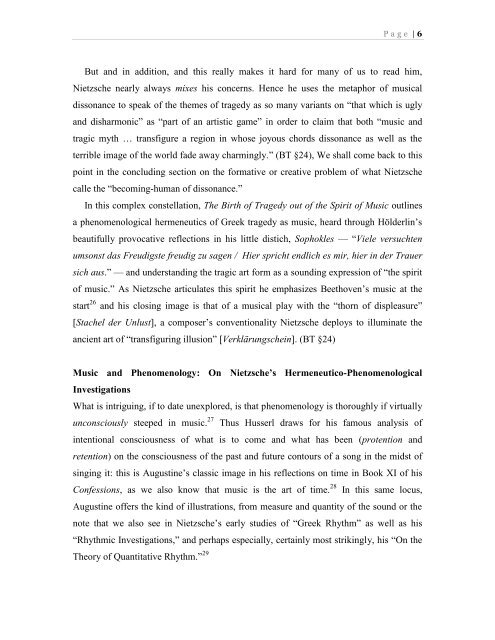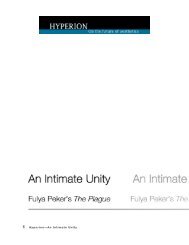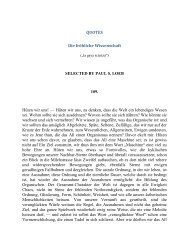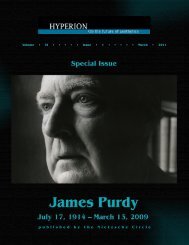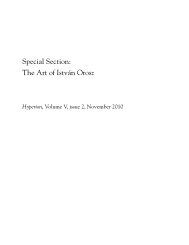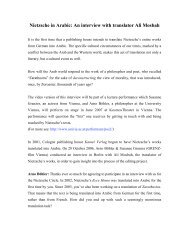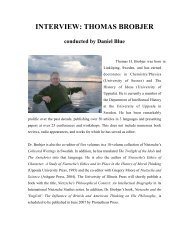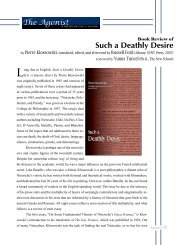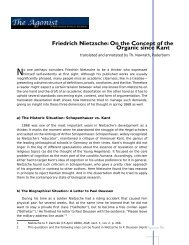Music, The Birth of Tragedy, and Nietzche's ... - Nietzsche Circle
Music, The Birth of Tragedy, and Nietzche's ... - Nietzsche Circle
Music, The Birth of Tragedy, and Nietzche's ... - Nietzsche Circle
You also want an ePaper? Increase the reach of your titles
YUMPU automatically turns print PDFs into web optimized ePapers that Google loves.
P a g e | 6<br />
But <strong>and</strong> in addition, <strong>and</strong> this really makes it hard for many <strong>of</strong> us to read him,<br />
<strong>Nietzsche</strong> nearly always mixes his concerns. Hence he uses the metaphor <strong>of</strong> musical<br />
dissonance to speak <strong>of</strong> the themes <strong>of</strong> tragedy as so many variants on “that which is ugly<br />
<strong>and</strong> disharmonic” as “part <strong>of</strong> an artistic game” in order to claim that both “music <strong>and</strong><br />
tragic myth … transfigure a region in whose joyous chords dissonance as well as the<br />
terrible image <strong>of</strong> the world fade away charmingly.” (BT §24), We shall come back to this<br />
point in the concluding section on the formative or creative problem <strong>of</strong> what <strong>Nietzsche</strong><br />
calle the “becoming-human <strong>of</strong> dissonance.”<br />
In this complex constellation, <strong>The</strong> <strong>Birth</strong> <strong>of</strong> <strong>Tragedy</strong> out <strong>of</strong> the Spirit <strong>of</strong> <strong>Music</strong> outlines<br />
a phenomenological hermeneutics <strong>of</strong> Greek tragedy as music, heard through Hölderlin’s<br />
beautifully provocative reflections in his little distich, Sophokles — “Viele versuchten<br />
umsonst das Freudigste freudig zu sagen / Hier spricht endlich es mir, hier in der Trauer<br />
sich aus.” — <strong>and</strong> underst<strong>and</strong>ing the tragic art form as a sounding expression <strong>of</strong> “the spirit<br />
<strong>of</strong> music.” As <strong>Nietzsche</strong> articulates this spirit he emphasizes Beethoven’s music at the<br />
start 26 <strong>and</strong> his closing image is that <strong>of</strong> a musical play with the “thorn <strong>of</strong> displeasure”<br />
[Stachel der Unlust], a composer’s conventionality <strong>Nietzsche</strong> deploys to illuminate the<br />
ancient art <strong>of</strong> “transfiguring illusion” [Verklärungschein]. (BT §24)<br />
<strong>Music</strong> <strong>and</strong> Phenomenology: On <strong>Nietzsche</strong>’s Hermeneutico-Phenomenological<br />
Investigations<br />
What is intriguing, if to date unexplored, is that phenomenology is thoroughly if virtually<br />
unconsciously steeped in music. 27 Thus Husserl draws for his famous analysis <strong>of</strong><br />
intentional consciousness <strong>of</strong> what is to come <strong>and</strong> what has been (protention <strong>and</strong><br />
retention) on the consciousness <strong>of</strong> the past <strong>and</strong> future contours <strong>of</strong> a song in the midst <strong>of</strong><br />
singing it: this is Augustine’s classic image in his reflections on time in Book XI <strong>of</strong> his<br />
Confessions, as we also know that music is the art <strong>of</strong> time. 28 In this same locus,<br />
Augustine <strong>of</strong>fers the kind <strong>of</strong> illustrations, from measure <strong>and</strong> quantity <strong>of</strong> the sound or the<br />
note that we also see in <strong>Nietzsche</strong>’s early studies <strong>of</strong> “Greek Rhythm” as well as his<br />
“Rhythmic Investigations,” <strong>and</strong> perhaps especially, certainly most strikingly, his “On the<br />
<strong>The</strong>ory <strong>of</strong> Quantitative Rhythm.” 29


